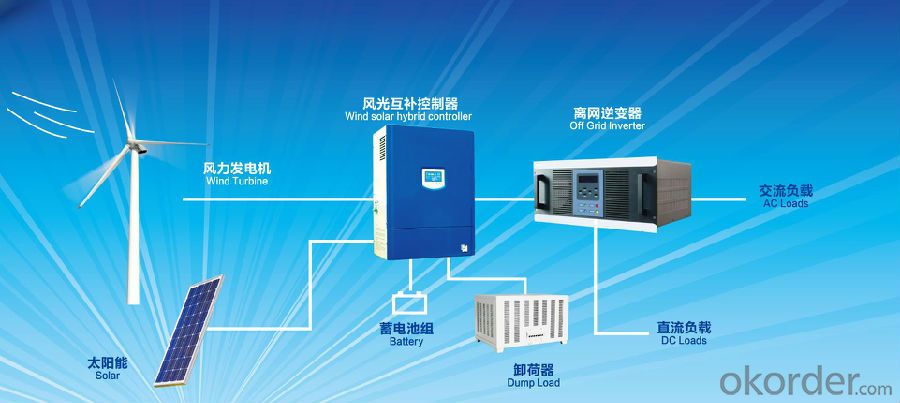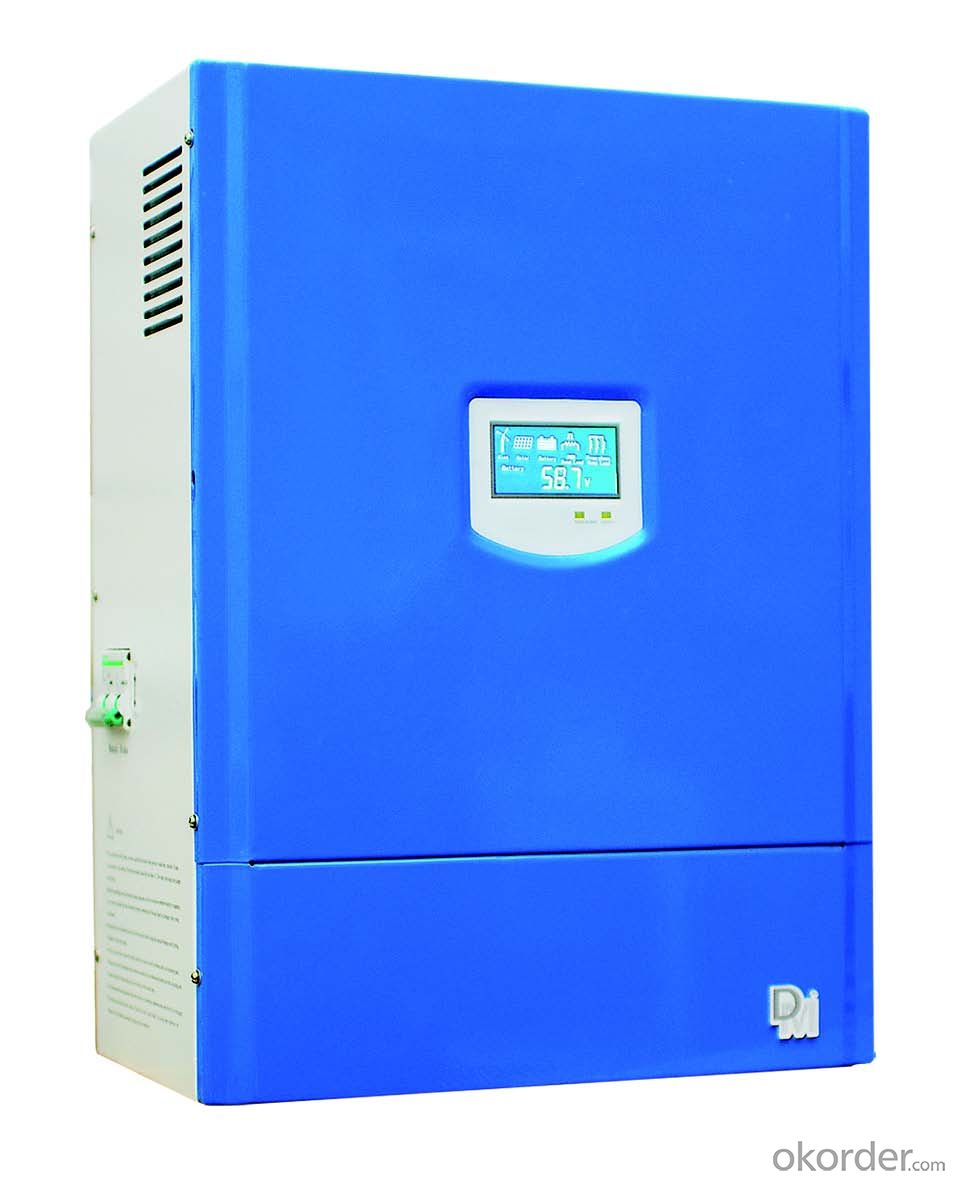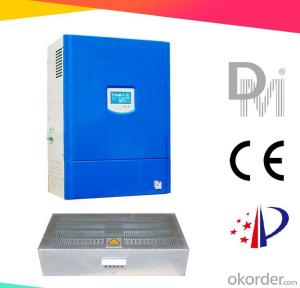Off-Grid PWM Wind Solar Hybrid Controller2KW
- Loading Port:
- Qingdao
- Payment Terms:
- TT or LC
- Min Order Qty:
- 1 unit
- Supply Capability:
- 1000 unit/month
OKorder Service Pledge
OKorder Financial Service
You Might Also Like

FKJ-B model Product Characteristics
◆The product is manufactured according the JB/T6939.1-2004 industrial standard and GB/T 19115.1-2003 national standard also with users’ technical requirements.
◆The big screen LCD display. Clearly present the working status of the wind turbine, solar panel, battery and controller.(Wind turbine voltage, current, power display ;solar voltage, current, power display, battery charging current, voltage, charging power, power display.)
◆Two sets of control systems:PWM constant voltage system and three-phase dump load system.
◆PWM constant voltage control is 120% of the rated power of the wind turbine. In case exceeding of PWM’s capacity, the three-phase dump load will automatically start immediately to ensure safe running of the overall wind turbine system.
◆When the battery disconnect or damage, the three-phase dump load will start automatically to avoid the wind turbine idling and runaway accident.
◆When the strong or super-strong wind conditions PWM control to ensure battery charged by the wind turbine with constant voltage and current.
◆The protection function of battery: polarity reverse protection, disconnection and damage protection.
◆Over-charging protection of the battery: When the battery is full (the battery voltage getting 125% of the rated voltage), the controller will carry out three-phase dump load automatically to stop charging the battery.
◆Auto recharging of battery: When the battery voltage reduces to 108% of the rated voltage,it stops three-phase dump load to recharge battery automatically.
◆For the different wind turbine type, the controller can be equipped with mechanical yawing, furled empennage, mechanical or hydraulic, pneumatic, electric magnetic and other brake functions.
◆The inside of the controller is equipped with surge arrester. Contain the over voltage into the wind turbine under the bearable voltage of the equipment or system. On the other way, to conduct the strong lightening current into the earth directly to avoid any damage of equipment.
◆The controller is equipped with manual three-phase dump load switch. To using this switch, the wind turbine will carry out three-phase dump load forcibly.
◆ Optional communication Mode:RS232、RS485、GPRS、USB、RJ45 ect, Can monitor multiple devices running.

Technical Parameters of the FKJ-B (PWM) Off - Grid Wind Solar Controller 2KW
Type | 2KW-24Vdc | 2KW-48Vdc | 2KW-96Vdc |
Wind turbine rated power | 2KW | 2KW | |
Wind turbine max. power | 4KW | 4KW | 4KW |
Solar panel power | 600Wp | 600Wp | 600Wp |
Battery | 24Vdc | 48Vdc | 96Vdc |
Function | Rectifier,charge, control | ||
Display mode | LCD | ||
Display content |
Wind turbine voltage, wind turbine current, wind turbine power, solar panel voltage, solar panel current, solar panel power, battery voltage, charge current | ||
PWM constant pressure voltage | >29Vdc | >58Vdc | >116Vdc |
3-phase load voltage of the wind turbine | 30±1Vdc | 60±1Vdc | 120±2Vdc |
Recovery charging voltage of the wind turbine | 27±1Vdc | 54±1Vdc | 108±2Vdc |
Solar controller stop charging voltage | 29±1Vdc | 58±1Vdc | 116±2Vdc |
Solar restore charge voltage | <29vdc< span=""> | <58vdc< span=""> | <116vdc< span=""> |
Low-voltage of the battery | 20±1Vdc | 40±1Vdc | 80±2Vdc |
Self-provided connecting wire of the battery | >20mm² | >10mm² | >24mm² |
PWM fuse | 100A | 50A | 20A |
Solar fuse | 40A | 20A | 10A |
Charging fuse | 125A | 63A | 32A |
Work environment temperature | -30-60°C | ||
Relative humidity | <90% No condensation | ||
Noise (1m) | <40dB | ||
Degree of protection | IP20 | ||
Cooling method | Forced air cooling | ||
*Communication interface (optional) | RS485/USB/GPRS/Ethernet | ||
*Temperature compensation (optional) | -4mv/°C/2V,-35°C~+80°C, Accuracy:±1°C | ||
Size of the controller (mm) | 480*360*130 | 480*360*130 | |
Weight of the controller | 23 Kg | 16 Kg | 16 Kg |
Size of the dump load (mm) | 395*300*125 | 395*300*125 | 395*300*125 |
Weight of the dump load | 6.5 Kg | 6.5 Kg | 6.5Kg |
*Above parameter only for reference
1. Could be custom made to user specifications.
2. Could have solar power control subject to user demand.
3. Size of the controller by blue meaning wall hanging case.
- Q:How do I protect a solar controller from moisture and humidity?
- To protect a solar controller from moisture and humidity, you can take several precautions. Firstly, ensure that the solar controller is installed in a dry and well-ventilated location. Avoid placing it in areas prone to water leaks or excessive humidity. Additionally, consider using a weatherproof enclosure or a protective cover specifically designed for solar controllers. These covers can help shield the controller from moisture and humidity while still allowing for proper airflow. Regularly inspect and maintain the controller, checking for any signs of moisture or condensation buildup, and promptly address any issues to prevent damage.
- Q:How does a solar controller handle power surges from the solar panels?
- The flow of power from solar panels to the battery bank or electrical grid is regulated by a solar controller, which is a crucial component in a solar power system. Safeguarding the system is a crucial role played by a solar controller when it comes to dealing with power surges from the solar panels. Power surges can occur due to various reasons like sudden changes in weather conditions, fluctuations in solar radiation, or issues with the solar panel itself. If not handled properly, these surges can potentially damage the system and its components. To handle power surges, a solar controller usually includes several protective mechanisms. One of its primary functions is to prevent overcharging of the battery bank. Whenever a power surge occurs, the solar controller detects the excess voltage and current and limits the charging rate to ensure that the battery does not get overcharged. This helps in maintaining the battery's health and prolonging its lifespan. Moreover, solar controllers often incorporate devices such as surge protectors or voltage clamps for transient voltage suppression. These devices help in absorbing and diverting excessive voltage spikes away from the system, thereby preventing damage to the solar panels, controller, batteries, or other connected devices. In addition, some advanced solar controllers utilize Maximum Power Point Tracking (MPPT) technology. This technology optimizes the power output of the solar panels by dynamically adjusting the voltage and current, even during power surges. MPPT controllers enhance the system's efficiency while minimizing the impact of power fluctuations. In conclusion, a solar controller regulates the charging rate to prevent overcharging, incorporates surge protection devices, and utilizes MPPT technology to optimize power output when handling power surges from the solar panels. These protective features ensure system stability, protect components from damage, and maximize the efficiency of the solar power system.
- Q:Can a solar controller be used with a solar-powered manufacturing plant?
- Yes, a solar controller can be used with a solar-powered manufacturing plant. A solar controller helps regulate and optimize the charging of batteries in a solar power system. In a solar-powered manufacturing plant, the solar controller can efficiently manage the flow of energy from the solar panels to the batteries, ensuring a stable and reliable power supply for the plant's operations.
- Q:Are solar controllers weatherproof?
- Yes, solar controllers are typically weatherproof. Solar controllers are designed to withstand outdoor conditions, including exposure to rain, snow, extreme temperatures, and other weather elements. They are constructed with durable materials and often have an IP (Ingress Protection) rating that indicates their level of protection against dust and water. However, it is essential to check the specific product specifications and IP rating of a solar controller to ensure it is suitable for the intended outdoor application.
- Q:Can a solar controller be used with solar-powered indoor government buildings?
- Solar-powered indoor government buildings can effectively utilize a solar controller. Also referred to as a charge controller, a solar controller plays a crucial role in a solar power system. Its main function is to regulate the flow of electricity between solar panels and batteries. This ensures that the batteries are efficiently charged and prevents any damage caused by overcharging. To generate electricity, solar panels in these buildings harness sunlight. This electricity powers various devices and systems within the building. In order to manage the charging process of the batteries that store this solar energy, a solar controller becomes necessary. By connecting the solar panels to the solar controller and then to the batteries, the solar controller can effectively monitor and control the charging process. This maximizes battery efficiency and lifespan. Furthermore, solar controllers often offer additional beneficial features, including temperature compensation, load control, and battery protection. These features are particularly important for indoor government buildings as they optimize the performance of the solar power system and ensure a reliable and sustainable power supply. Therefore, it is highly advisable to incorporate a solar controller in conjunction with solar-powered indoor government buildings. This guarantees the efficient and safe operation of the solar power system.
- Q:Can a solar controller be used with a battery bank that is connected in parallel?
- Yes, a solar controller can be used with a battery bank that is connected in parallel. The solar controller regulates the charging process of the batteries by controlling the amount of current flowing from the solar panels to the batteries. Whether the batteries are connected in parallel or series, the solar controller will still be able to monitor and regulate the charging process effectively.
- Q:Can a solar controller be used with a wind turbine as a hybrid renewable energy system?
- Yes, a solar controller can be used with a wind turbine as a hybrid renewable energy system. The solar controller can be employed to regulate the charging of the batteries connected to the wind turbine, ensuring optimal energy storage and distribution. This combination allows for the utilization of both solar and wind energy sources, maximizing the overall efficiency and reliability of the renewable energy system.
- Q:Does a solar controller have surge protection?
- Yes, a solar controller typically includes surge protection. Surge protection is a crucial feature in solar controllers as it safeguards the solar panels and other components of the solar system from voltage spikes and power surges. These spikes can occur due to lightning strikes, grid fluctuations, or other electrical disturbances, and can potentially damage or destroy the solar controller and other connected devices. Surge protection in a solar controller helps to absorb and redirect these voltage spikes, ensuring the smooth and safe operation of the solar system.
- Q:What is the maximum charging temperature a solar controller can handle?
- The maximum charging temperature that a solar controller can handle varies depending on the specific model and manufacturer. However, in general, most solar controllers are designed to withstand temperatures up to 60-70 degrees Celsius (140-158 degrees Fahrenheit) without any significant impact on their performance or durability.
- Q:Can a solar controller be used with a solar pool heater?
- Yes, a solar controller can be used with a solar pool heater. A solar controller helps regulate and optimize the performance of the solar panels by monitoring the temperature and flow rate of the pool water. It ensures that the pool heater operates efficiently and effectively.
1. Manufacturer Overview |
|
|---|---|
| Location | |
| Year Established | |
| Annual Output Value | |
| Main Markets | |
| Company Certifications | |
2. Manufacturer Certificates |
|
|---|---|
| a) Certification Name | |
| Range | |
| Reference | |
| Validity Period | |
3. Manufacturer Capability |
|
|---|---|
| a)Trade Capacity | |
| Nearest Port | |
| Export Percentage | |
| No.of Employees in Trade Department | |
| Language Spoken: | |
| b)Factory Information | |
| Factory Size: | |
| No. of Production Lines | |
| Contract Manufacturing | |
| Product Price Range | |
Send your message to us
Off-Grid PWM Wind Solar Hybrid Controller2KW
- Loading Port:
- Qingdao
- Payment Terms:
- TT or LC
- Min Order Qty:
- 1 unit
- Supply Capability:
- 1000 unit/month
OKorder Service Pledge
OKorder Financial Service
Similar products
New products
Hot products
Hot Searches
Related keywords





























